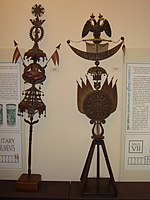Piazza Euclide railway station (Rome)
Railway stations in RomeRailway stations located underground in Italy

The Piazza Euclide railway station is a railway station in Rome (Italy), on the Rome–Civitacastellana–Viterbo railway, managed by ATAC. It is the only underground stop of the line, excluding the Flaminio terminus. The official name of the facility is Stazione Euclide, as shown on the signs visible from the square; in the past, however, it was indicated on the railway timetables as Roma P. Euclide or, in another source, as p.za Euclide.
Excerpt from the Wikipedia article Piazza Euclide railway station (Rome) (License: CC BY-SA 3.0, Authors, Images).Piazza Euclide railway station (Rome)
Via Filippo Civinini, Rome Pinciano
Geographical coordinates (GPS) Address Nearby Places Show on map
Geographical coordinates (GPS)
| Latitude | Longitude |
|---|---|
| N 41.9266 ° | E 12.4813 ° |
Address
Via Filippo Civinini
Via Filippo Civinini
00197 Rome, Pinciano
Lazio, Italy
Open on Google Maps








